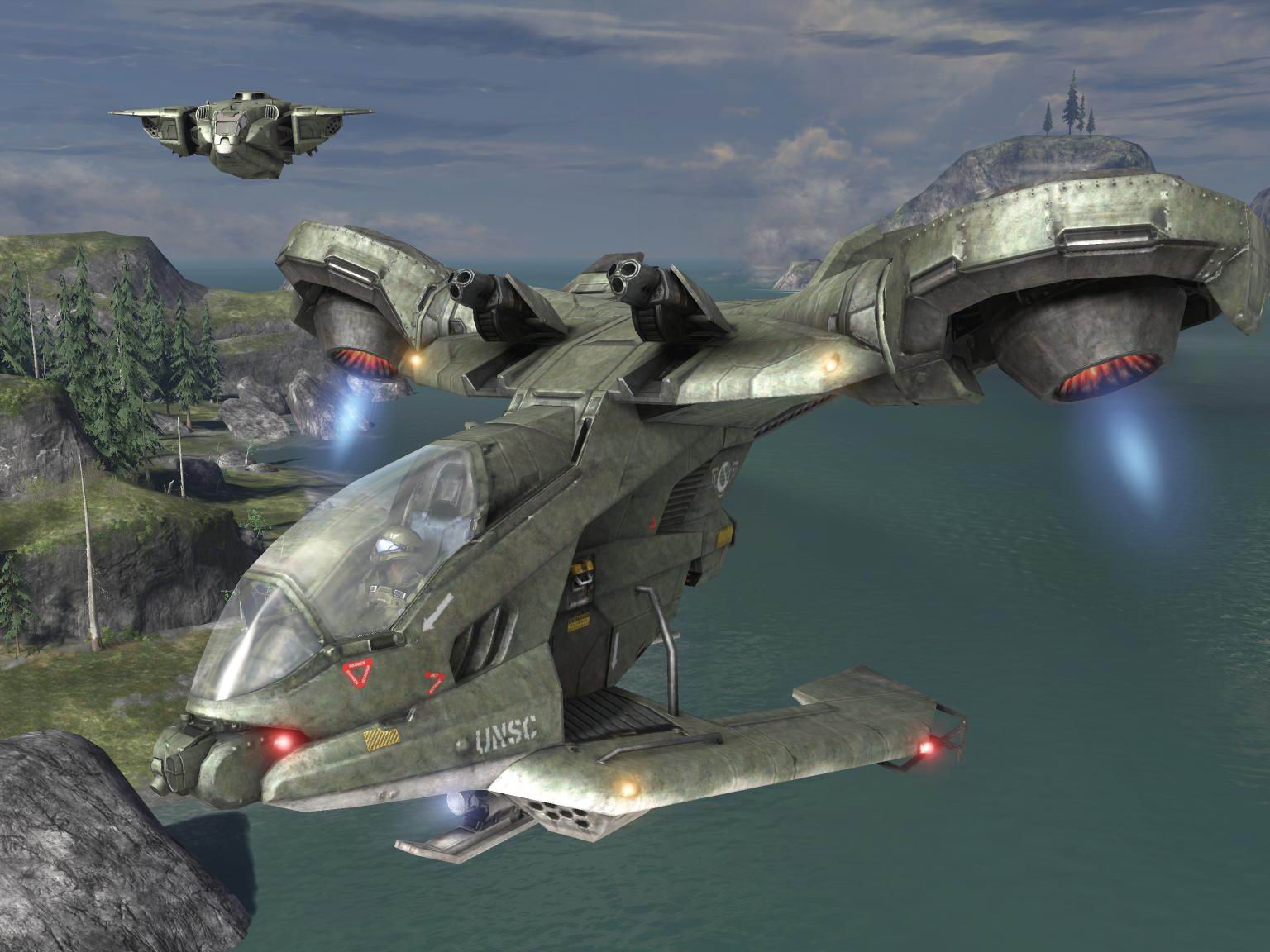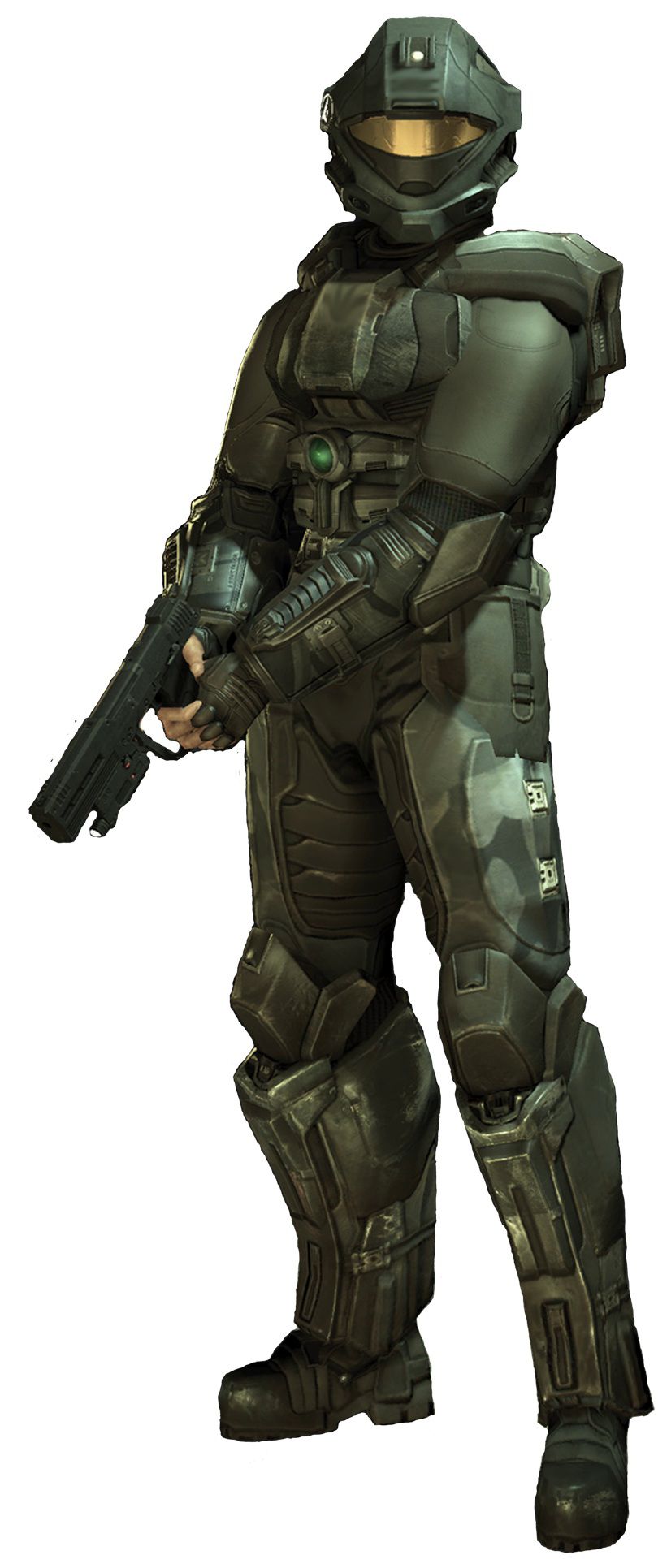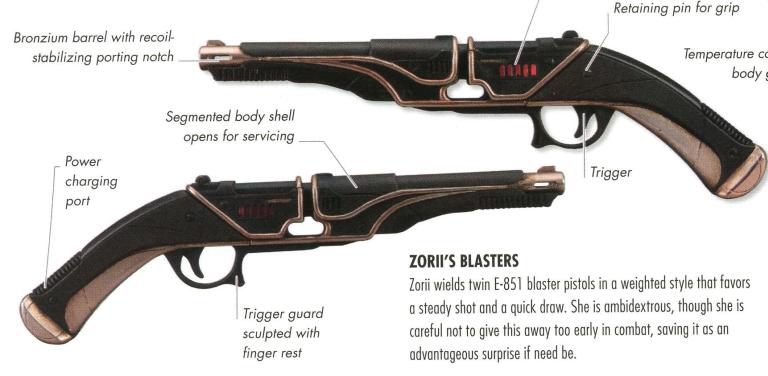 HORNET
Craft: UNSC AV-14 Hornet Attack VTOL
Type: Multi-role combat aircraft
Scale: Speeder
Dimensions:
-Length: 4.5m
-Width: 5m
Skill: Aircraft operations: Hornet
Crew: 1
Crew Skill: Aircraft operations 4D, missile weapons 3D, vehicle weapons 3D
Passengers: 4
Cargo Capacity: 20kg
Cover:
-Crew: Full
-Passengers: 1/4
Altitude Range: 500m
Cost: 75,000 cR (new), 55,000 cR (used)
Maneuverability: 2D
Move: 365; 1,050 kmh
Body Strength: 3D
Defenses:
-Chaff Pod:?+3D (4 uses, see below)
WEAPONS:
?? 2 Rotary Cannons (fire-linked)
?? ? ?Location: Mounted in wings behind cockpit
?? ? ?Fire Arc: Front
?? ? ?Crew: 1 (pilot)
?? ? ?Skill: Vehicle weapons
?? ? ?Scale: Speeder
?? ? ?Fire Control: 3D
?? ? ?Range: 2-25/100/500m
?? ? ?Damage: 4D
?? ? ?Ammo: 500 each (7.62mm rounds)
?? ? ?Rate of Fire: 4 (Automatic)
?? 2 Class-2 GMLS (fire-linked)
?? ? ?Location: Mounted under the belly in the landing skids
?? ? ?Fire Arc: Front
?? ? ?Crew: 1 (pilot)
?? ? ?Skill: Missile weapons
?? ? ?Scale: Speeder
?? ? ?Fire Control: 2D
?? ? ?Range: 25-100/200/400m
?? ? ?Missile Speed: 400m per round
?? ? ?Damage: 6D/5D/4D (5D per missile)
?? ? ?Blast Radius: 0/1/2
?? ? ?Ammo: 10 (5 missiles per pod)
?? ? ?Rate of Fire: 1
DESCRIPTION:
???The AV-14 Attack VTOL, colloquially known as the Hornet, is a United Nations Space Command airborne assault vehicle.
- - - - - - - - - -
AUTOMATIC WEAPONS: The Hornet's rotary cannons are automatic machine guns, able to fire multiple shots in a single attack, and even more with some effort. ?The listed Rate of Fire is to represent firing in short bursts for accuracy. ?To fire more shots, add+1 to the range Difficulty for every +1 shot added to the Rate of Fire. If an attack rolls the normal Difficulty but not the higher Difficulty needed for more shots, then 1 shot hits and 3 miss (no more, as the gunner would stop firing to line up a better shot for the next attack).
TARGET LOCK: The Hornet's Class-2 Guided Munitions Launch System (GMLS) is able to lock onto other aircraft (not ground vehicles) for a better chance to hit with its missiles. ?The Hornet/pilot must aim for 1 round (this seems rather hard, but the Hornet must maintain visibility of the intended target without ducking into cover before firing), then fire it's missiles with a?+2D to hit. ?If the missiles miss the target they have a skill of 4D to reengage (hit again) if the Hornet pilot can maintain the target lock (by still maintaining visibility of the target).
CHAFF POD: The Hornet has a chaff pod to help defend it against incoming fire. ?The chaff is only effective against weapons that use electronics or other guidance systems to aid in hitting a target. ?Most missile systems will be susceptible to this, though many shoulder-launched missile systems can be used without such guidance systems. ?If a weapon has a Fire Control listing, then the Chaff Pods work, granting a bonus to dodge these attacks for up to 4 uses. ?If the incoming attack does not have a Fire Control listing, then any use of the Chaff Pods is useless against the attack and wastes one of their uses. ?The Hornet has sensors that can detect target locks. ?These were also never useful Halo 3 or Halo 3 ODST, but were an upgrade in Halo Wars.
- - - - - - - - - -
DESIGN DETAILS
???The AV-14 is a vertical take off and landing vehicle (VTOL) that has been in service since at least 2424. It serves as the UNSC's assault, search and reconnaissance and close air support aircraft. The Hornet is an atmospheric craft and as such cannot be deployed by orbital vessels unless a ship rated for atmospheric entry can deliver it to the battlefield. It is easier for the Hornet to be deployed from an air base located on the surface than from a ship.
???The AV-14 Hornet consists of a one-man cockpit and a rear section, extending approximately one meter backward. Variant models feature a tandem seating configuration, presumably allowing a second passenger to operate the aircraft's weaponry or navigation systems. At the top of this rear section are a set of wings with what appear to be advanced turbofan engines mounted on gimbals at the ends, providing the Hornet's main source of propulsion. The front of the Hornet contains a target acquisition and designation system which includes cameras and sensors. On each side of the cockpit is a jump-seat extending backward that doubles as a landing skid. These skids allow up to four passengers.
???Although the AV-14 Hornet primarily serves as an attack craft, like most UNSC hardware it is flexible, able to serve as a multi-purpose vehicle, and can be configured for a particular role ? variant models include the AV-14 Reconnaissance and the AV-14 Transport and dependent upon mission requirements can be customized accordingly.
ARMAMENTS
???The AV-14 Hornet is armed with both anti-infantry and anti-vehicle weapon systems, and is configurable to adjust to any task required. The AV-14 Hornet can be configured with one of two anti-infantry systems. The first is a system configuration containing two triple-barreled fire-linked rotary cannons. These are located on either side above the cockpit on the leading edges of the wing. The guns fire synchronously, and can be elevated and depressed to a small degree, without affecting the flight pattern of the Hornet. The second is a single, nose mounted GUA-23 Linkless Feed Autocannon that fires .50 BMG rounds. The anti-vehicle system is composed of two Class-2 Guided Munition Launch Systems, that are mounted on the belly of the aircraft's landing skids. When triggered, each pod fires a single missile. Like the LAU-65D/SGM-151 missile system, the Class-2 GMLS is capable of achieving a target lock. In addition the Hornet can be armed with two chaff pods to counter radar-guided missiles. These are copper nickel-coated glass fibers or silver-coated nylon fibers having lengths equal to half of the anticipated radar wavelength.
ADVANTAGES
???The AV-14 Hornet is known for its efficiency in combat situations; its multi-purpose role allows the vehicle to take on a wide array of missions and can perform without any major problems. In its role as an attack craft the AV-14 is very effective at hunting down and destroying armor with relative ease; the homing Class-2 GMLS can take down the toughest Covenant armor in only a few strikes, making it the UNSC's prime choice for hunting down tanks. Its ability to engage infantry also makes the AV-14 both an offensive and defensive aircraft; the triple-barrel rotary cannons can take down heavily armored and shielded targets with little effort, and its ability to place itself in a stationary position to lay down cover fire while a larger craft retrieves fellow infantry also allows it to perform its role as a support craft. The firepower on the craft is also an added bonus when escorting other aircraft into dangerous territory that could be susceptible to ground fire. Its role as a support craft is further bolstered by its ability to easily insert small strike teams into combat situations.
DISADVANTAGES
???While the AV-14 Hornet has a wide variety of roles and advantages, its greatest weakness is its light armor ? making it susceptible to anything larger than small arms fire. Although the Hornet is rather nimble, it lacks the maneuverability of the D77-TC Pelican and AV-22 Sparrowhawk, which can occasionally be a liability in combat conditions. Infantry atop of the vehicles landing skids are also at risk of taking enemy fire, as they have no protection at all which is why the AV-14 Hornet is often used to insert small strike teams, and not extract them in combat operations. The risk of casualties from anti-aircraft fire mandates the use of more heavily armored aircraft like the D77-TC or the UH-144 Falcon for extraction.
OPERATIONAL HISTORY
???The AV-14 Hornet first entered service during the UNSC's campaign against the Insurrectionists. It played a big part in Operation: TREBUCHET and was used to provide support to infantry on the ground and to insert strike teams into combat zones. Two Hornets were used during a raid on Tribute in 2524 Hornets were used to insert two teams of special forces troops into hot zones and when it was safe to retrieve a insurrectionist who told the UNSC of their method of making explosives.
The AV-14 Hornet remained in service nearly three decades later during the Human-Covenant War, serving during the Battle of Arcadia, the Battle of the Flood Controlled Shield World, and was a common sight during the Battle of Earth. Deploying strike teams and providing support during the Battle of Cleveland and provided SPARTAN-117 support during the Battle of Voi ? after arriving at the Ark the Hornet became the primary escort and air support craft for the UNSC during the final moments of the war.
OTHER INFO
Production Information:
-Manufacturer: UNSC
-Model: AV-14
Technical Specifications:
-Engine: Advanced Turbofan/Turbojet Engine
-Armament:?Class-2 Guided Munition Launch System and?Missile Launchers (2); 2?3-barreled Gatling guns (possibly AIE-486H Heavy Machine Guns)(2)
-Crew: Pilot (1); Gunners (2, optional)
Usage:
-Year Introduced: 2424
-Role(s):?Main Air;?Close Air Support;?Light Troop Transport;?Light Anti-Vehicle
-Era(s): Insurrection; Human-Covenant War
-Affiliation: United Nations Space Command
|












